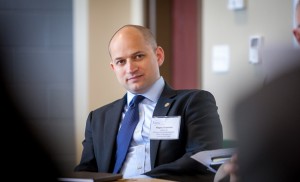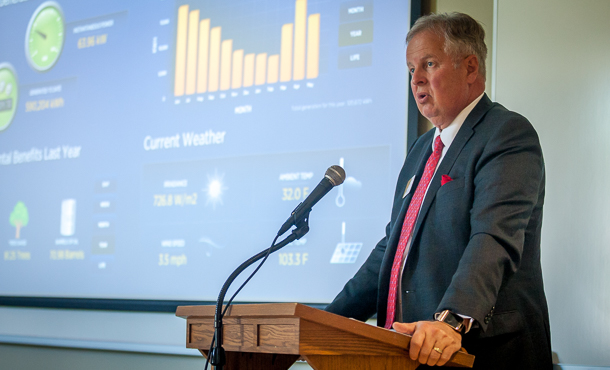Virginia’s private colleges are taking the lead in growing the capacity of solar energy in the state. That was the message during last week’s Council of Independent Colleges in Virginia (CICV) Solar Pathways Briefing, hosted by Eastern Mennonite University (EMU).
The briefing marked the early stages of a three-year plan to double Virginia’s solar capacity through installations on 15 private college campuses. The project is being led by CICV, with more than $807,000 in federal grant funding from the Department of Energy SunShot Initiative.

Representatives from private colleges, as well as officials from the Department of Mines, Minerals, and Energy and the Office of the Attorney General, attended the May 22 meeting to learn more about project objectives and to share knowledge about the legal, political and regulatory frameworks within which these projects operate.
Approximately 50 attendees also heard an endorsement from Governor Terry McAuliffe, offered by keynote speaker Hayes Framme, advisor for infrastructure and development in the Office of the Secretary of Commerce and Trade.
“This is an exciting project.… This collaboration among the private higher ed institutions through the entire state is an important project to demonstrate the value of comprehensive strategic planning and coordination to drive down [solar] costs,” Framme said. “About 25 megawatts are installed currently and when completed, this project will double the amount of installed capacity in Virginia.”
Solar commitments aided by sustainability as a core value
As examples of “solar success stories,” EMU President Loren E. Swartzendruber joined Washington and Lee University president Kenneth Ruscio to speak about groundbreaking solar projects on their respective campuses, with both offering frank advice about educating and negotiating with various groups of stakeholders. EMU’s solar array atop the Hartzler Library was the largest in Virginia at the time of installation until surpassed by Washington and Lee’s two arrays.
In introducing the panelists, CICV project manager Carol Wampler acknowledged the foundation laid by both universities and their administrations. Such a learning network, as evidenced in the briefing, is one goal of the collaborative initiative, she said. “We’re trying to prepare for the other colleges who will be following in the footsteps of these two colleges who were pioneers.”
Swartzendruber began his overview of EMU’s solar projects by underscoring the university’s commitment to sustainability and environmental protections. “It’s a commitment that rests on the foundation of a Mennonite value to be good stewards of the gift of creation,” he said. “Most of us here at EMU believe that climate change and disruptions are a reality and we are deeply concerned that the impact of global warming will have the most devastating and negative impact on the most vulnerable and the poorest populations of the world.”
EMU’s solar energy projects have widespread support on campus and among administration and board of trustee members, which smooths the path through the complexities of collaborative solar procurements, he said. These procurements, which join together private partnerships and government agencies, take time, energy and significant collaboration to happen.
Ruscio, who was president when Washington and Lee planned and built a solar installation that surpassed EMU’s in 2012, pointed out past successes don’t make certain continued investment. The university’s board recently postponed plans for a massive solar field that would power a new residential hall. Ruscio cautioned that planning processes demand a high level of communication. “Institutional decision making at the core level” is fragmented, he said, and a holistic integrated approach in presenting these kinds of projects to various stakeholders is necessary to circumvent what he called “veto points.”
Campus surveys ongoing
CICV’s project has several components, explained Tyler Espinoza, a consultant with Optony, a Silicon Valley-based firm which has pioneered the model of collaborative solar procurement. In a 2010 project, Optony brought together nine government agencies to procure 14 megawatts of solar energy; similar projects have happened successfully on the east coast in central New York and greater Washington D.C.
Espinoza says project goals are “ambitious, but realistic,” adding that in a nearly complete survey of all college campuses involved, he has already identified potential array sites that would total 20 megawatts. “I don’t anticipate it being a problem with the remaining campuses to fulfill 30 megawatts.”
Site visits and feasibility assessments conclude in mid-2015, he said, and bids will be solicited for installment of the solar energy equipment that schools choose in early 2016. The ultimate goal of the project, Espinoza said, is to create and implement a replicable plan for participating institutions to deploy solar electricity within five years.
